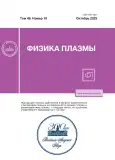Relevance of the Wigner–Seitz Cell Approximation for the Coulomb Clusters
- Autores: Shpil’ko E.S.1,2, Zhukhovitskii D.I.1,2
-
Afiliações:
- Joint Institute for High Temperatures, Russian Academy of Sciences
- Moscow Institute of Physics and Technology (National Research University)
- Edição: Volume 49, Nº 10 (2023)
- Páginas: 1003-1009
- Seção: ПЫЛЕВАЯ ПЛАЗМА
- URL: https://journals.rcsi.science/0367-2921/article/view/232795
- DOI: https://doi.org/10.31857/S0367292123600590
- EDN: https://elibrary.ru/EQDRKD
- ID: 232795
Citar
Texto integral
Resumo
A molecular dynamics simulation of a system of massive charged particles on a compensating homogeneous background confined by a spherical surface has been carried out. A crystallized cluster is a set of nested spherical shells of almost the same structure and a core. It is shown that cluster melting is a combination of shell and core melting. It is found that the values of the Coulomb coupling parameter Γ corresponding to these two types of melting do not depend on the cluster size. Methods for determining Γ based on the Wigner–Seitz cell model are discussed. It is shown that the estimate based on the root-mean-square deviation of a particle from the center of its cell is unreliable due to the self-diffusion of particles. A relation is proposed that defines Γ in terms of the root-mean-square velocity and acceleration of the particle and does not include the root-mean-square deviation of the particle from its average position. It is shown that this relation is satisfied with high accuracy not only for the crystallized, but also for the liquid state. Thus, it has been demonstrated that the Wigner–Seitz cell model is applicable to the strongly inhomogeneous system under consideration.
Palavras-chave
Sobre autores
E. Shpil’ko
Joint Institute for High Temperatures, Russian Academy of Sciences; Moscow Institute of Physics and Technology (National Research University)
Email: dmr@ihed.ras.ru
125412, Moscow, Russia; 141701, Dolgoprudny, Moscow oblast, Russia
D. Zhukhovitskii
Joint Institute for High Temperatures, Russian Academy of Sciences; Moscow Institute of Physics and Technology (National Research University)
Autor responsável pela correspondência
Email: dmr@ihed.ras.ru
125412, Moscow, Russia; 141701, Dolgoprudny, Moscow oblast, Russia
Bibliografia
- Slattery W.L., Doolen G.D., De Witt H.E. // Phys. Rev. A. 1980. V. 21. P. 2087. https://doi.org/10.1103/PhysRevA.21.2087
- Hamaguchi S., Farouki R.T., Dubin D.H.E. // Phys. Rev. E. 1997. V. 56. P. 4671. https://doi.org/10.1103/PhysRevE.56.4671
- Complex and Dusty Plasmas: From Laboratory to Space. Series in Plasma Physics / Eds. V. E. Fortov and G. E. Morfill. CRC Press: Boca Raton, FL, 2010.
- Arp O., Block D., Klindworth M., and Piel A. // Phys. Plasmas. 2005. V. 12. P. 122102. https://doi.org/10.1063/1.2147000
- Arp O., Block D., Bonitz M., Fehske H., Golubnychiy V., Kosse S., Ludwig P., Melzer A., and Piel A. // J. Phys.: Conf. Series. 2005. V. 11. P. 234. https://doi.org/10.1088/1742-6596/11/1/023
- Käding S., Melzer A. // Phys. Plasmas. 2006. V. 13. P. 090701. https://doi.org/10.1063/1.2354149
- Block D., Käding S., Melzer A., Piel A., Baumgartner H., Bonitz M. // Phys. Plasmas. 2008. V. 15. P. 040701. https://doi.org/10.1063/1.2903549
- Arp O., Block D., Piel A. // Phys. Rev. Lett. 2004. V. 93. P. 165004. https://doi.org/10.1103/PhysRevLett.93.165004
- Totsuji H., Ogawa T., Totsuji C., Tsuruta K. // J. Phys. A: Math. Gen. 2006. V. 39. P. 4545. https://doi.org/10.1088/0305-4470/39/17/S36
- Apolinario S.W.S., Albino Aguiar J., Peeters F.M. // Phys. Rev. E. 2014. V. 90. P. 063113. https://doi.org/10.1103/PhysRevE.90.063113
- Wineland D.J., Bergquist J.C., Itano W.M., Bollinger J.J., Manney C.H. // Phys. Rev. Lett. 1987. V. 59. P. 2935. https://doi.org/10.1103/PhysRevLett.59.2935
- Dubin D.H.E., O’Neil T.M. // Rev. Mod. Phys. 1999. V. 71. P. 87.
- Zhukhovitskii D.I., Naumkin V.N., Khusnulgatin A.I., Molotkov V.I., Lipaev A.M. // Phys. Rev. E. 2017. V. 96. P. 043204. https://doi.org/10.1103/PhysRevE.96.043204
- Baiko D.A., Yakovlev D.G., De Witt H.E., Slattery W.L. // Phys. Rev. E. 2000. V. 61. P. 1912. https://doi.org/10.1103/PhysRevE.61.1912
- Chugunov A.I., Baiko D.A. // Physica A. 2005. V. 352. P. 397. https://doi.org/10.1016/j.physa.2005.01.005
Arquivos suplementares














